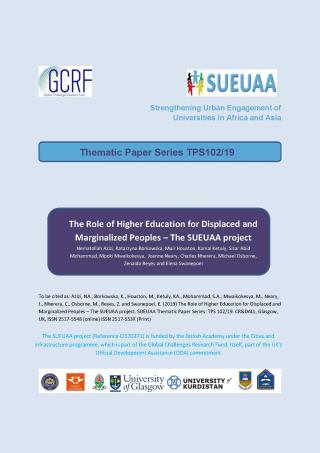In a series of SUEUAA working papers, the team will focus on overarching themes (environment, policy, gender, migration, and the economy), and show the similarities and differences across the different study cities in terms of the capacity of the University to respond to these city-wide issues. The second paper focuses on the role of Universities in environmental resilience in cities.
Each working paper is a collaborative process, and is co-authored by academics in at least three cities.The second paper is co-authored by Lavinia Hirsu (University of Glasgow), Zenaida Reyes (Philippine Normal University), Kamal Aziz Ketuly and Sizar Abid Mohammad (University of Duhok), Nematollah Azizi (University of Kurdistan) and Mpoki Mwaikokeysa (University of Dar-es-Salaam).
Title: Impact of University engagement on environmental resilience of urban spaces in Asia and Africa
Abstract: By 2030 most of the globes inhabitants will be living with cities. It is therefore important that cities are resilient to sustenance and energy challenge in the face of increasing demands from population expansion and increasing environmental variability and uncertainty brought about by intensifying climate change. The Strengthening Urban Engagement of Universities in Asia and Africa (SUEUAA) project aims to enhance university engagement capacity in this context and optimise engagement strategy to maximise impact in urban areas. We use the term ‘environmental resilience’ to encapsulate both energy and sustenance challenges. We believe these must be tackled in a holistic manner as there are intimate links between the production and usage of energy, food and water and consequent generation and disposal of waste. This paper focuses on the experiences and vision of SUEUAA partners in Johannesburg (South Africa), Dar es Salaam (Tanzania), Duhok (Iraq), Sanandaj (Iran), and Manila (Philippines), so it encapsulates views and solutions for engagement strategies on several environmental challenges facing cities in very different climatic situations.
To access this paper, please click the attachment below.

